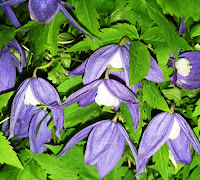'The deeper a man digs for knowledge in his garden the more he realises that he has only scratched the surface'
 |
| Easter chicks |
Not only is April a busy month in the flower garden but, traditionally, it heralds the start – in the North certainly – of serious work on the allotment front; most of which has already been dug over and perennial weeds removed, ready for the serious ask of potato planting which is traditionally done here on Good Friday.
Seed potatoes had already been purchased and placed in egg boxes with the ends with the most ‘eyes’ uppermost. They were then kept in my Two Hoots shed at the allotment until new shoots had begun to sprout – this is known as chitting. I’m growing first earlies – International Kidney (the Jersey Royal potato) together with Sharpe’s Express and the Saxon variety of second earlies. I’ve decided not to plant any maincrop potatoes this year and to use the space saved for more purple sprouting broccoli and extra rows of leeks, both of which will withstand the winter months and be used to make welcoming soup early next year.
Flicking through Niall Edworthy’s The Curious Gardener’s Almanac I read that the baked potato man was a common sight in London streets selling hot potatoes to passersby. It was estimated that in the nineteenth century there were more than 250 itinerant hot potato sellers plying their trade. Edworthy states that ‘Most English gentlemen wouldn’t be seen dead eating a vulgar potato in the street, but they often bought them as hand-warmers during the harsh winters of the time’.
This took me back to my teens when, on Bonfire Night, the family, including my young cousins – my little Aunt’s grandchildren – would all go to watch the firework display in Spennymoor’s Jubilee Park. My Aunt would have sausages and onions baking in the oven ready for us to eat on our return.
She had already baked jacket potatoes in the coal oven which, when wrapped in foil, were given to the little ones to carry in their pockets to keep their mittened hands warm. The temptation was usually too much for them, however, and the potatoes were usually eaten long before the bonfire was lit! (One of those little tots celebrates his 50th birthday this weekend. Unbelievable).
As last year, I have taken garden guru Monty Don’s advice and planted salad crops – Little Gem and Salad Bowl lettuce together with rows of radishes – on top of the rows of potatoes. These will be ready to harvest well before the potatoes are ready to be earthed up and this is an excellent way to cram as many plants as possible in the space available.
 |
| Assorted seed pa |
In the home garden the greenhouse is full of seed trays, planted up with both annuals – jewel mixed nasturtiums, sunflowers, helichrysum, larkspur (inspired by beds of them seen at Highgrove last year), bells of Ireland, cosmos (Sensation and Purity) sweet peas (the original Cupani together with Matuca; greenhouse plants – cayenne chilli peppers, Spanish mixed peppers, cucumbers, and 9 different types of tomato; in addition to vegetables to be planted out later at the allotment – sweetcorn Swift, courgettes (the yellow Jemmer and the traditional green zucchini, calabrese, Musselburgh leeks, butternut squash and celery.
I still have some sowing to do – herbs, especially different forms of basil and the wonderfully fragrant coriander, and mixed Tuscan and Provençal salads which I grow in window boxes placed near the kitchen door for ease of harvest. There is nothing nicer than popping outside and snipping young, tender salad crops to add to a lunchtime sandwich. The effort is minor and the cost is minimal.
There can be no comparison with the extortionate, pre-washed, pre-packed, tasteless ‘salads’ available in supermarkets. Why not try growing it for yourself?
My mouth is watering already!























